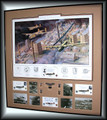 Loading... Please wait...
Loading... Please wait...Categories
Our Newsletter
- Home
- Combat Aircraft/Pencil Drawings ~ Free Shipping
- XFY-1 "POGO" ~ Free Shipping
Product Description
Print Size 8½" x 11" ----- Unlimited print edition
The Convair XFY Pogo tailsitter was an experiment in vertical takeoff and landing. The Pogo had delta wings and three-bladed contra-rotating propellers powered by a 5,500 hp Allison YT40-A-16 turboprop engine. It was intended to be a high-performance fighter aircraft capable of operating from small warships. Landing the XFY-1 was difficult as the pilot had to look over his shoulder while carefully working the throttle to land. On 19 April 1954, a Convair engineering test pilot and Marine reserve, Lieutenant Colonel James F. "Skeets" Coleman, made the first tethered flight in the Pogo. The XFY-1 was like no other propeller driven aircraft before it. No previous aircraft with a similar weight, engine power, or size had ever attempted to take off and land vertically. For the safety of both the craft and its pilot, the first test consisted of the propeller hub cover being removed and replaced with safety tether lines for a case in which the Coleman would lose control of the craft and would need to be tethered to prevent the craft falling to the ground. On the other end of the tether was another engineer, Bob McGreary. If Coleman ever lost control, McGreary controlled the winch which could be turned to raise the tethers to prevent the craft from plummeting to the ground. For further safety preventions, four security cables were fastened to each wing in case control was lost in any axis. Throughout the next few weeks, Coleman logged almost 60 hours in test flights in the Pogo, and by August, the test was moved to outdoor conditions. On 1 August 1954, Coleman logged two outdoor test flights, the second flying 150 feet into the air, and shortly after he flew 70 takeoff-landing drills at the Naval Auxiliary Air Station in Brown Field, California. The first conversion to horizontal flight took place on 2 November 1954. But upon later flights with longer durations, flaws in the design were found. Due to the Pogo's lightweight design, and the lack of spoilers and air brakes, the aircraft lacked the ability to slow down and stop efficiently after moving at high speeds. Landing was also a problem, as the pilot had to look back behind himself during a landing to properly stabilize the craft. Due to these problems, the XFY Project was put on hiatus.













